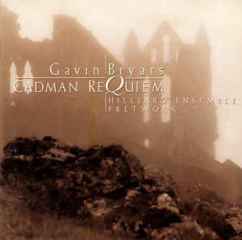Gavin Bryars - Cadman Requiem (1998)
Gavin Bryars - Cadman Requiem (1998)

01 Cadman Requiem - Requiem 02 Cadman Requiem - Caedmon Paraphrase (Bede) (John Potter, tenor) 03 Cadman Requiem - Agnus Dei 04 Cadman Requiem - Caedmon's ''Creation Humn''(Gordon Jones, bariton) 05 Cadman Requiem - In Paradisum Hilliard Ensemble: alto - David James tenor - Roger Covery-Crump baritone - Gordon Jones Fretwork: treble viols - Richard Campbell, Wendy Gillespie tenor viols - Julia Hogson, Susanna Pell bass viol - Richard Boothby great bass viol – William Hunt 06 Adnan Songbook - Song I 07 Adnan Songbook - Song II 08 Adnan Songbook - Song III 09 Adnan Songbook - Song IV 10 Adnan Songbook - Song V 11 Adnan Songbook - Song VI 12 Adnan Songbook - SongVII 13 Adnan Songbook - Song VIII Soprano – Valdin Anderson Gavin Bruards Ensemble: violas – Bill Hawkes, Andrew Parker celo – Sophie Harris double-bass – Gavin Bryars electric and acoustic guitar – James Woodrow bass clarinet and clarinet – Roger Heaton conduktor – Dave Smith 14 Epiloque from Wonderlawn Gavin Bruards Ensemble: violas – Bill Hawkes celloa – Sophie Harris, Ziella Bryars, Orlanda Bryars double-bass – Gavin Bryars bass clarinet – Roger Heaton guitar – James Woodrow
Cadman Requiem was written in memory of Bryars’s sound engineer, Bill Cadman, who was killed in the Lockerbie plane crash, and for the most part it’s a dark, harmonically bare piece. The vocal writing, which is often in unison, is perfectly offset by the plangent timbre of the viols. Bryars sets only part of the requiem text, and interpolates two settings of the seventh-century English poet Caedmon (pun intended): in these there is more rapid movement in the underlying texture, though the harmonies always change slowly. A near comparison might be Arvo Pärt, though Bryars is much more quirky, and you never encounter quite what you expect around the corner. You certainly can’t imagine Pärt setting the love poems in the Adnan Songbook – nor a more sensitive response than Bryars’s. The lyrical vocal lines (beautifully sung by Valdine Anderson) unfold with serenity over an accompaniment of low strings, clarinets and guitars, sometimes sustained, sometimes pulsing gently, sometimes moving rapidly, and always in a state of harmonic flux. Epilogue from Wonderlawn, a meditation for viola and small ensemble is harmonically the simplest work on the CD, but is no less affecting for that. In the booklet notes, Bryars writes of his care in choosing the sequence of music on the CD, and the natural progression from darkness into light makes this a totally satisfying listen from beginning to end. ---Martin Cotton, classical-music.com
I had written the Cadman Requiem in 1989 for the Hilliard Ensemble in memory of my friend and sound engineer Bill Cadman, who was killed in the Lockerbie air crash. His death affected me very deeply and, pending a recording of this piece, Manfred Eicher asked if I might like to develop an instrumental work from this, using the same instrumentation for accompaniment and retaining the same opening bars as part of a new ECM album. The piece is "after" the Requiem therefore in the musical sense of being based on it, in the chronological sense of following on from it, and in the spiritual sense of representing that state which remains after mourning is (technically) over. I wrote the piece in Venice in September 1990 and finished it in Oslo on the day of the recording, where I added the electric guitar of Bill Frisell. This, I felt, blended particularly well with low strings (originally 2 violas and cello; in live performance sometimes viola, cello and bass). Coincidentally, having used certain distortion effects on the guitar, we found that we were recording on the twentieth anniversary of the death of Jimi Hendrix. Within the music I use one or two modified extracts from the Cadman Requiem itself, and from its common source Invention of Tradition, for which Bill Cadman had done the sound design.
The piece is dedicated to the two Bills (Cadman and Frisell). ---Gavin Bryars, gavinbryars.com
download (mp3 @320 kbs):








